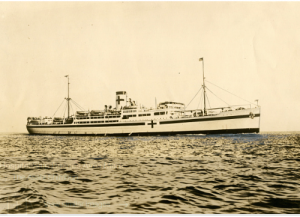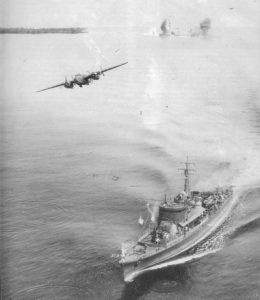- Author
- Editorial Staff
- Subjects
- Ship histories and stories, History - WW2
- Tags
-
- RAN Ships
- None noted.
- Publication
- September 2018 edition of the Naval Historical Review (all rights reserved)
Was the sinking of hospital ships isolated incidents which could be put down to mistaken identity or were they deliberate acts of destruction by those who had thrown away the rule book? With twenty-four hospital ships recorded as being sunk by enemy action during WWII it is difficult to reconcile that these were all accidental. These covered vessels of most belligerents, in numerical order losses were: Italy (7) Britain (5) Greece (4) Japan (3) Germany (2) and Australia, Norway and Russia one each. The most infamous was the loss of the Russian hospital ship Armenia when bombed and sunk by German aircraft in 1941 after evacuating civilians and wounded soldiers from Crimea, with over 5,000 deaths and only eight survivors. Remarkably the United States of America lost no hospital ships in this conflict. By comparison the Australian Hospital Ship Centaurat 3,222 tons was a small ship but with a large number of persons aboard including 75 crew, 55 medical staff and 192 passengers from the 2/12th Field Ambulance on passage to New Guinea. When torpedoed and sunk on her maiden voyage as a hospital ship she carried no patients but 268 lives were lost.
There is plentiful information on the tragic sinking of Centaur by a Japanese submarine in the early hours of 14 May 1943 and that of our greatest maritime tragedy, in terms of lives lost, the sinking of the Japanese transport Montevideo Maru when taking Australian POWs from Rabaul on 01 July 1942, but other related incidents have gone unreported.
Wah Sui
One of the great Allied tragedies of WWII was the fall of Singapore in February 1942. Because of suspected vulnerability to enemy aggression a few days before the surrender a decision had been made to evacuate as many European non-combatants as possible. Of special concern were women and children and patients from service hospitals, including female nursing staff. Just about anything that floated was used in this evacuation from Singapore to the then relative safety of the Dutch East Indies. Overall it was not a success with the majority of vessels being sunk with great loss of life amongst the 5,000 evacuees.
With no hospital ship available three small flat-bottomed Yangtze river boats were hastily converted into makeshift hospital ships and painted white with red crosses on their sides. They were not internationally registered hospital ships and it could be argued by disregarding international regulations they brought registered ships into jeopardy.
One of these ships, Wah Sui, came to Singapore. When fully laden with 450 passengers, mostly Australian and British wounded tended by six Australian Army nursing sisters, she sailed from Singapore on 12 February bound for Tandjong Priok in Java which could be covered in about three days steaming.
Prior to her sailing Japanese authorities had advised the local British command to move the Wah Sui further away from the main shipping channel as she was in danger of being accidentally bombed. After sailing she was buzzed by Japanese aircraft but unmolested. Later she was challenged and stopped by a Japanese cruiser who sent a boarding party to examine her. She was again allowed to proceed and safely made Tandjong Priok where her passengers were disembarked and hospitalised awaiting other opportunities to make their way home. In this instance the six Australian nurses were transferred to the troopship Orcades and reached Adelaide a few weeks later.
Buenos Aires Maru
Surprisingly we also know little of the sinking of the Japanese Hospital Ship Buenos Aires Maruin what might be regarded as Australian waters, off the Mandated Territory of New Guinea on 27 November 1943.
Buenos Aires Maru was a passenger-cargo ship similar to Montevideo Maru, both vessels requisitioned to help the Japanese war effort. Built in 1929 for the Osaka Shosen Kaisha (OSK) Line the Buenos Aires Maru was a 9,627 ton passenger-cargo ship, accommodating 1,200 passengers, and was mainly employed in the pre-war immigrant trade between Japan and South America. In November 1941 she was requisitioned as a troop ship plying between Japan, China, Korea and the Philippines. In October 1942 she was converted to a hospital ship and on 21 November 1942 the Japanese Ministry of Foreign Affairs notified warring powers that Buenos Aires Maru is now a protected hospital ship.
Notwithstanding her new status, when in the South China Sea on 25 April 1943 this relatively large ship was damaged by torpedoes fired by the submarine USS Runner. The ship’s hull was slightly damaged and seven men were wounded. The ship was taken to Hong Kong for repairs.
On 17 August 1943 en route for Rabaul in New Britain she was attacked by an unknown American aircraft but escaped undamaged. The following day she arrived at Rabaul where she is described as being painted white with a green stripe around her hull, with large red crosses on either side of her hull and funnel. A black and white photograph exists from this time showing her hospital ship markings. She makes several more voyages between New Britain and the Philippines.


On 22 November 1943 she arrives at Rabaul where she embarks 1,129 sick and wounded servicemen, plus a small number of servicemen being repatriated to theirhomeland. In addition she carried 63 nursing staff and an unknown number of crew. The total number of passengers on board is estimated at about 1,300 personnel.
At about 0800 on 27 November when off the northern coast of New Guinea province of New Ireland the ship was subjected to low level bombing by an American Army Air Force B-24 Liberator. The raid was conducted in broad daylight in clear weather with the aircraft flying at low altitude. A bomb struck the port side of the ship, opening up the hull and flooding the engine room. The ship sank bow first about 50 minutes later. Remarkably in this relatively short space of time the survivors were taken off in lifeboats and two motor boats. The Liberator left the scene shortly after the sinking and is said to have strafed the area with machine gun fire, seemingly with little effect.
A small Japanese Navy submarine chaser squadron of three ships was based at Kavieng in northern New Ireland. Some days later one of these sub-chasers rescued about 1,000 survivors but 158 men and nurses were missing assumed killed in the bombing, sinking or dying later in the lifeboats.
This went unreported by Australian media who may well have been unaware of the incident. However the Australian War Memorial (AWM55 6/6) does have an unpublished interrogation report taken from a Japanese soldier (JA 147007) who was discovered in a life raft off the north coast of Bougainville and rescued by American soldiers on 16 December 1943. He had been aboard Buenos Aires Maru and was being transported back to Japan because of sickness. He was subsequently able to tell of conditions aboard the ship prior to, and during, her attack and evacuation.
Brigadier General Dr. Percy Carrol, the Command Surgeon, United States Army in the Southwest Pacific recommended an apology be made for this unfortunate mistake. However, General McArthur vetoed this recommendation and no apology was made.
In contrast Prime Minister John Curtin made a clear statement to the Australian Parliament in respect of the attack on Centaur which he said: …bore all the marks of wantonness and deliberations. The deed will shock the conscience of the whole civilized world. It will demonstrate to all who have any lingering doubts the unscrupulous and barbarous methods by which the Japanese conduct warfare.
A report of a subsequent United States Government investigation into the sinking of the Buenos Aires Maru was issued from Washington on 5 February 1944 through the Spanish Embassy, which was in charge of Japanese interests in Continental United States. It was stated that at the time of the bombing the identity of the hospital ship was not evident until after the attack was made. Regarding the alleged machine gunning of drifting lifeboats it was again stated that their identity was unknown. While the United States Government expresses its sincere regrets it emphasises the accidental nature of the attacks.
Summary
The Buenos Aires Maru tragedy underscores that such attacks are perpetuated by warring nations and alleged mistakes can be evenly divided by both sides in conflict. The story of Wah Suialso shows that the Japanese were conscious of international regulations regarding hospital ships and in this instance observed these to the letter.




